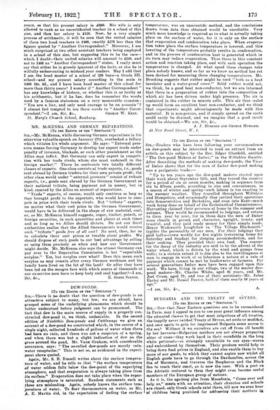DEW-PONDS. -
[To THE EDITOR OP TRE "SPECTATOR."] SIR,—There is no doubt that the question of dew-ponds is an attractive subject to many, but few, we are afraid, have -grasped some of the underlying phenomena which should be better understood before judgment can be pronounced. The -fact that dew is the main source of supply in a properly con- structed dew-pond is, we think, undeniable. In the second edition- of Neolithic Dew-ponds and Cattleways we give an account of a dew-pond we constructed which, in the course of a single night, collected hundreds of gallons of water when there had been no rain, and there was not a suspicion of a spring, and when there was but a slight indication of dew on the grass eround the pond. Mr. Vaux Graham, with considerable assurance, says: "The so-called dew-ponds are merely rain- water receptacles." This is not so, as evidenced in the experi- ment above quoted.
Again, Mr. S. B. Russell writes about the surface tempera- ture of water, and he tells us that "the surface temperature .of water seldom falls below the dew-point of the superlying atmosphere, and that evaporation is always taking place from its surface." Evaporation does not take place when the super- lying atmosphere is saturated. Random statements such as these are misleading. Again, nobody knows the surface terns yerature of water. To float thermometers on water, as Mr, A.. E. Martin did, in the expectation of finding the surface
temperature, was an unscientific method, and the conclusions drawn from data thus obtained would be unreliable. Very much more knowledge is required as to-what is actually taking place on the surface of water, for it is only on the surface that evaporation and condensation take place. When evapora- tion takes 'place the surface temperature is lowered, and this lowering of the temperature probably results in condensation, and in the process of condensation heat is generated which in its turn may induce evaporation. Thus there is this constant action and reaction taking place, and with each operation the temperature is changed. At what speed these changes take place nobody knows, and so far as we know no method has yet been devised for measuring these changing temperatures. Mr. Brooking suggests that rubber might be used "both as a heat insulator and a water-proof cover." Solid rubber would not. we think, be a good heat non-conductor, but we are informed that there is a preparation of rubber into the composition of which air has been driven under high pressure. The air is contained in the rubber in minute cells. This air thus sealed up would form an excellent heat non-conductor, and we think that experiments might advantageously be made with this material. It is non-porous, and if simply spread on the earth could easily be drained, and we imagine that a good result would be obtained.—We are, Sir, &c.,


































 Previous page
Previous page